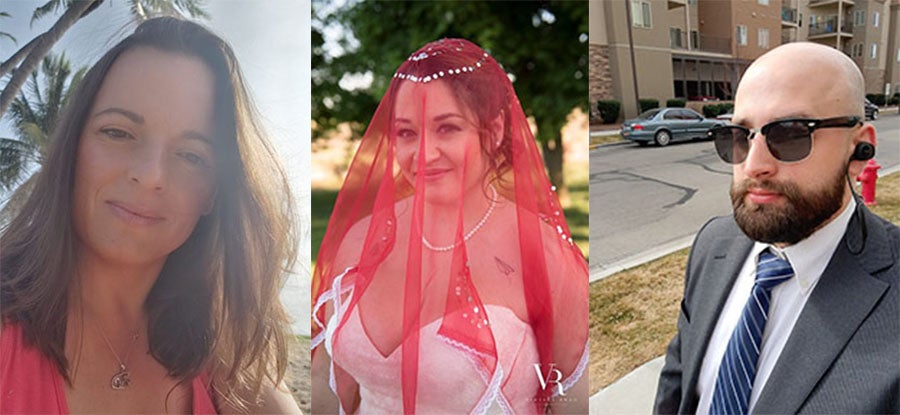
Boise State is home to many unique and talented individuals who make up the fabric of our university. Each student has a varied path that led them here – from rural Idaho or across the globe – each call Boise, and Boise State home.
Idaho, and Boise have a long history of resettlement of individuals and families that have come to our local community as refugees. Boise is the home of the Agency for New Americans which is a nonprofit that has resettled over 3300 refugees from 33 countries as well as an office of the International Rescue Committee. Boise State currently has 128 undergraduate refugee students enrolled for Spring 2022.
Three of these refugee students, Irena Sisic, Fatima Alicehajic, and Darmin Hadzic, are alumni or current students in the department of radiologic sciences. Together with their families they braved the unthinkable – making a journey across the globe to escape war – all in search of a better, safer life.
“Fatima, Darmin, and Irena all are standout students and share so many positive attributes. Top of mind qualities for each of them are intelligence, kindness, compassion, maturity, and strong communication skills” said Travis Armstrong, clinical instructor and clinical coordinator for the Department of Radiologic Sciences.
“Each of these students can always be counted on to be highly engaged and dependable. Course work is of very high quality and feedback from their time completing clinical rotations at our partner institutions is invariably very positive. I know I speak for all faculty and staff in the radiologic science department when I say that we are so grateful that we get to work with students and people of the caliber of Fatima, Darmin, and Irena,” Armstrong said.
Irena’s Journey
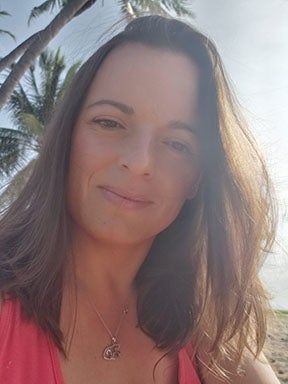
Irena Sisic was born in a country formerly known as Yugoslavia. Yugoslavia once consisted of seven Republics that now, post-war, are all independent countries. Sisic’s immediate family consists of her parents and two older brothers. Before the war, they lived in Bosnia in a small-town bordering Croatia. When Sisic was in fourth grade the war broke out and her family had to leave Bosnia. They ended up running towards Serbia where they lived until her parents heard that you could apply for an immigration visa to come and live in the United States.
The immigration process consisted of multiple interviews and the last question they asked was if they had somewhere specific they would like to go. Sisic and her family had hopes of living in a similar climate as where they once called home. No hurricanes, tornadoes, and most importantly somewhere where their children could go to school, and they could work to provide their family with a normal life and opportunities to succeed.
Once Sisic and her family arrived in Boise, her parents and oldest brother went straight to work while her other brother finished high school and went on to get his degree from Boise State. Once Sisic graduated high school, she completed a medical administrative assistant course and took a job working in the insurance industry. In 2009 Sisic’s mom had a hemorrhagic stroke, and it was the first time Sisic experienced the world of imaging sciences.
“I was blown away, the mix of working with technology and patients and other medical personnel and how in this field it all meshed together I was amazed and wanted to know more,” Sisic said.
“My personal journey at Boise State has been somewhat colorful, and undecided but once I discovered this program for Radiology Technologist, I knew that this is the career that I wanted to pursue, because I took on care for my mom, it took a bit for me to get all of the pre-req courses out of the way and once I did I applied, I was put on the waitlist and unfortunately ended up not getting into the program,” Sisic said.
Sisic is married and has two kids who saw her work and study hard and she wanted them to see her achieve this accomplishment. It was devastating to have to tell them that she didn’t get accepted.
“I told my husband first and as we talked he told me not to lose faith in myself and to not give up and just wait for the next round and apply again, and our kids know how hard I work and will now know that even when things don’t go as planned to keep working hard and to keep pushing forward, which is exactly what my parents taught me when they decided to move to a whole new country without speaking the language, working any jobs possible and still pushing forward,” Sisic said.
Sisic applied again, did her interview, and was once again put on the waitlist, but was told she was the first one on the list. Sisic was heartbroken but she decided to keep taking classes to try to get a general degree in health science, and to enjoy the summer with her family. Towards the end of summer, she received a phone call from Catherine Masters, program director, who told Sisic there was one spot left and if she still wanted to join the program it was hers. Of course, Sisic said yes and that following Monday she started her journey.
“Once I am done with this program I would like to keep working in the field and gain as much experience as possible, whether it is working for a large hospital or one of the smaller urgent care places. It will give me time to get even more knowledgeable and comfortable with all things x-ray. I do know that Boise State does have an MRI and CT programs which is great because it could provide me with even more opportunities to succeed in this field outside of school,” Sisic said.
Armstrong believes that students bring to bear their unique life experiences to their training and future work as healthcare professionals.
“As the clinical coordinator in the diagnostic radiology program it is my hope and view that we train a future healthcare workforce that is reflective of and sensitive to the community that we serve,” Armstrong said. “I believe students such as Fatima, Darmin, and Irena have a deep understanding of the unique needs of the members of our community that arrived as refugees. I believe that this will naturally enhance the health care experience and outcomes for all involved.”
Fatima’s Journey
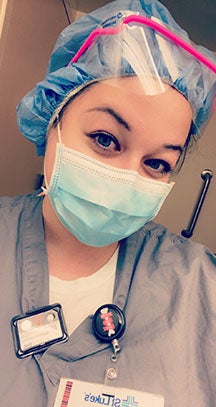
Fatima Alicehajic’s parents were successful business owners in a small town in Southeastern Europe called Teslic. Teslic was considered a part of Bosnia and Herzegovina and since the war, it is now considered a part of Serbia. When Alicehajic was just over a year old, everything was taken from them. The Serbian military started performing ethnic cleansing of their beautiful country and its innocent people. The harsh and ugly reality is that they were raping and killing women and children that were too young to work.
Boys and men who were old enough to hold a gun were given the option to kill their own until they themselves were killed, or they would be sent to a concentration camp. As of this year, they are still finding unidentified bodies in mass graves from the war. Alicehajic’s family was lucky they acted at the first sign of trouble, but there were many families who did not.
Alicehajic had family in Germany so they knew this was going to be a safe refuge. Due to paperwork issues, Alicehajic’s parents had to split up on their journey to safety. Her mom had to stay with neighbors, and remained in hiding in a crawl space below their home. Her dad, however, started an incredibly stressful journey with Alicehajic in his arms and her nine year old brother by his side.
Had Alicehajic’s brother and dad been caught by the Serbian military, they would have been forced to do the unthinkable. Alicehajic most likely would have been killed as she would have been deemed useless at the age of one. Until the day her dad passed away, he lovingly referred to her as “his thirteen months” because it was his belief that she was the reason they made it out of Bosnia alive.
When Alicehajic was thirteen months old they were making their way out of the country when they approached a Serbian soldier who was checking passports for those boarding a bus leaving town. Normally they wouldn’t have been able to board the bus, but Alicehajic’s dad said the soldier had looked down at her “bright blue eyes” and she smiled at him joyfully so the soldier took pity on them and let them leave with the other passengers. Alicehajic’s father retold that story many times throughout her life to remind her of how he felt about the significance of that day. Fortunately, Alicehajic’s mom joined them safely in Germany a few weeks later after making the trip by herself.
Alicehajic and her family lived in Germany for about six years when President Clinton granted refuge to displaced Bosnians to the United States and her family arrived in Hayward, California.
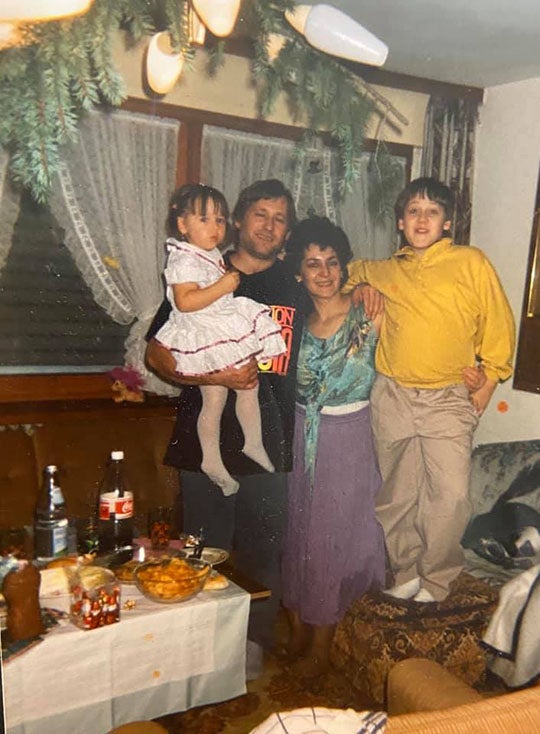
“We could no longer stay in Germany due to their laws, and what was once our home no longer existed so we had no other option. By this time, I was fluent in Bosnian and German, my brother and I were going to school in Germany and had made close friends. We were not happy about moving to a completely new country. Our first glimpse of America was streets of gang violence, hard drugs, and break-ins. We were assigned a social worker and each started learning English and trying to start over again,” Alicehajic said.
After about a year of living in California, Alicehajic’s father worked hard enough to save money to buy a home in Idaho. He worked endless hours as a pizza delivery driver, janitor, long distance truck driver, and literally anything else he could think of to make money while he supported his family.
While living in California they met another Bosnian family, became close friends and were able to lean on each other. They heard there was a larger Bosnian community in Boise, it was safer, and much more affordable, so the two families decided to move to Idaho together.
“Boise State University offered an accessible and affordable education for me, as someone who did not want to go far from home, yet wanted a good education” Alicehajic said. “Boise State allowed me to reach my educational goals while also providing me with ample opportunity to be involved in organizations that helped me post graduation. I utilized on-campus resources to help me figure out ‘what I wanted to be when I grow up,’ build my resume, provided me with suggestions and connections for leadership opportunities and even helped guide me through the application process for the radiologic sciences program. I spent my “growing up” years at Boise State.”
Alicehajic currently works for St. Luke’s in their computerized tomography department – a place where she worked before earning her radiologic sciences degree.
“I consider myself truly fortunate to work at St. Luke’s, as I worked at the same hospital before I began the radiology program and it was my goal to work in the imaging department when I finished schooling. Whenever I walk by my old desk, I remember where I came from and how hard I worked to be where I am today,” Alicehajic said.
Darmin’s Journey
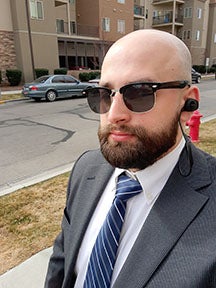
Darmin Hadzic was born in the city of Banja Luka in Bosnia shortly before the Yugoslav wars began, so he has never experienced Bosnia without war. Hadzic’s parents and older sisters remember their escape from the war-torn cities much more vividly, but his earliest memories were actually of the refugee camps. Long rows of canopies in a dirt lot were what he considered home for the beginning of his life. Each time his family had to relocate, they had to give up some of their possessions. Eventually, Hadzic’s father was able to arrange a flight to the United States where they had relatives who moved years prior.
Hadzic and his family spent their first few years in Twin Falls, Idaho making ends meet and paying off the loans his father took to get them out of Bosnia. Hadzic’s mother worked as an interpreter and his father, lacking proof of his college education, had to work at a trailer assembly company. Over the years, Hadzic gradually gained a grasp on the English language and was able to obtain his citizenship. After high school Hadzic joined the United States Navy to be able to afford college and to pay the United States back for allowing him and his family to live here.
Following his naval service, Hadzic returned to Twin Falls for college and to help his parents. He worked as a hospital corpsman in the Navy which is where he developed an interest in the medical field. Once he completed his associates degree in health science he applied to Boise State University in their bachelors program in radiologic sciences. Boise State was still close enough that he could help his family – which was his primary motivation.
“Boise State has helped me gain proficiency in the imaging field in a time when the public is in need of healthcare workers. I am able to hone my skills in the field while at the same time able to give back to the community. I am somewhat older than my peers, but I still feel a sense of belonging at this campus,” Hadzic said.
Hadzic has traveled to many countries – he was born in Europe, raised in North America and worked for much of his naval career in the far east – but still considers Idaho his home.
“I have pursued medicine as a career ever since I left high school. I helped in many settings while enlisted so I was able to see many sides of the healthcare profession. By comparing and contrasting the different fields, I determined that imaging fit me best. I am happy to see that I am enjoying my current clinical experiences,” Hadzic said.
Hadzic is in his senior year here at Boise State and currently works at St Luke’s Boise as a radiologic technologist although his current schedule only allows him to work on the weekends.
“This field allows me the flexibility to go to various places, so I am likely to take advantage of that by becoming a traveling tech. I am also considering working in hospitals in US bases overseas. This is still some time off, however, as I intend to pursue computed tomography and magnetic resonance imaging first,” Hadzic said.
“We have been very fortunate to have had many students in our radiologic sciences department programs that themselves or their parents came to our region as refugees” Armstrong said.
Boise State, and Idaho are very fortunate to have these brave, colorful students who help bond the fabric of our university.